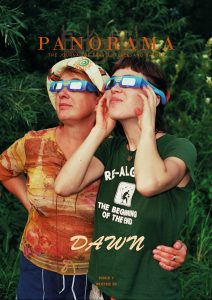The sun peeks through green leaves and branches, encasing the dome beneath the canopy in a brilliant light show. With every gentle touch of the wind, the leaves rustle, as if gossiping with each other in both loud and hushed tones: who is this earthen being that dares walk into our world? Like invisible, mythical creatures, the breeze lightly plays with your hair, tickling your ear and brushing against your cheek as you listen to their foreign gossip. The few streaks of golden sunlight piercing its way through the thick foliage dance to an otherworldly tune… branches swaying to the lullaby of the humble breeze. The orchestra of gushing winds and chirping birds swells, and then, all at once, it quiets into an eerie yet serene silence. As if the air itself is alive, tingling with energy, you feel as if you’ve stepped into another world—one of magic and stories of both miracles and tragedy.
The largest and considered to be one of the most beautiful in the Cadore area, the Somadida Forest boasts a diverse and thriving flora and fauna. She calls the Somadida Oriented Nature Reserve home, free to conquer the over 1600 hectares of land with its far-reaching roots and woody authority. The Norway spruces (Pieca abies), silver firs (Abies alba), larches (Larix decidua), and beeches (Fagus sylvatica) stand tall, grounding themselves deep into the soil—unshakable. To sustain themselves, these living giants must overcome the shadows that the Dolomite mountains cast over the forest. The majestic peaks of Mt. Cristallo and Mt. Sorapiss tower above the trees, obstructs the sunlight rays that give these wooden giants life. However, it is this challenge to survive that has made these trees some of the tallest in the area. They stand proud and strong; their coarse trunks bearing the scars of the hardships they’ve endured.
Through the test of time they have grounded themselves deep into their Italian home for over 500 years. Some of these earthen brethren, having been uprooted, have faced wars, seeing defeat and victory, as these precious woods were exploited by the Serenissima for its naval fleet until 1797, when it came under French rule. It’s a historical place, the Somadida forest… complex in its own right. In fact, the area contains rocks belonging to different eras (from the Middle and Upper Triassic to the gray limestone from the Lower Jurassic), and you’ll see the vegetation shift and morph into something else entirely the higher in altitude you explore. From thick wooded vegetation filled with spruce, to larch and pine typical of a rigid alpine climate. Even they know how to adapt to the changing conditions. But for how long?
Unseen beneath that soil, a whole other world exists: a tangle of roots twist and turn like an inescapable maze. They intertwine with one another, roots from different trees coming together as one single mass to create a system essential for providing water and nutrients to the giants that live above.
You walk atop this chaotic order of the invisible life-giving labyrinth beneath the soil. The soft ground under your feet makes little noise as you trudge through the earthly kingdom bathed in green. Like an imposter, you feel as if you’re being watched. Maybe it’s the birds of prey — the buzzard, the goshawk, or even the tawny owl — hidden among their wooden habitat keeping a close eye on your every move. How do I fit in here? The slight tilt of the head from a creature above asks the same question: what are you doing here? And yet, you know you never will… not in this wildly tame sanctuary that so many creatures call home.
So different from the concrete jungle, the aroma of freshly cut grass and fallen rain overwhelms your senses in a way that oven-baked bread and hot-brewed coffee simply cannot. Away from the hustle and bustle of Italian cities marked with tourists and pasta, the Somadida Forest is, in itself, its own living city.
Wooden apartments tower above you, and if you look closely enough, maybe you’ll catch a glimpse of one of its residents: a peregrine falcon or a golden eagle, perhaps. Or maybe even a deer or a fox… Unlike the concrete jungles humans call cities, the Somdida Forest does not run on a hasty schedule of deadlines and rush-hour traffic. Instead she follows along the tranquil flow of the Ansiei stream, trusting where the water leads.
Glad to leave the race of time behind, even just for a moment, to escape reality, you take in all the beauty the Somadida has to offer. You marvel at its glory and its story of survival; you know it is a beauty that will not be quickly snatched away, even by the angry gods above.
You continue walking, staring high towards the sun, barely catching a glimpse of the bright blue sky beyond the knitted intricacies of leaves and branches. Then, for the first time since entering the forest, you focus on the ground and trail before you. The path, a long winding curve, leads you deeper into the magic kingdom, away from the concrete roads and bus that took you here. Your footsteps fall silently as your feet walk atop the softness of fallen leaves and twigs. Your eyes trail a bright yellow butterfly fluttering from one flower to the next, until it lands on a pile of logs. You turn away, daring to look deeper into the forest’s secrets… only to be captivated by the logs again. What’s so special about them? Maybe it was the light tricking your eyes before, but you now realize that they, in fact, are not logs.
Lining your path, on each side of you, are entire tree trunks, several meters long, stacked sideways atop each other. Like corpses lining a battlefield, some are streaked red and others laid bare. The contrast between their proud standing brothers is striking. Everywhere else around you, desperate for sustenance and energy, wooden limbs and joints are stretching to reach the sky. But others, it seems, have lost or, even, given up the fight to survive as you watch them lie helpless along the forest path. You trek deeper into the center of the forest, the fallen soldiers on either side a constant reminder of what could happen if the balance of nature is tipped dangerously by human hands. As you wonder the story behind the fallen trees, your feet, as if with a mind of its own, take step after step following the winding forest path. The ethereal golden light and green foliage fades away as you allow your imagination to whisk you to that fateful November night in 2018 when this very forest cried out for help.
Giant raindrops fell from the sky and splashed onto the ground as violent storms raged the Italian province of Belluno. The never-before-seen force that tore through the area turned the forest’s earthy ground into mush and mud. Except for the few moments of bright white light when furious lightning streaked across the sky, everything was dark. Thousands of wooden soldiers who had assembled camp in the Somadida forest for centuries, instantly wiped out by vicious winds. The violent boom of limbs cracking and giants plummeting ripped through the sky. But even the cries of these tree-giants were not loud enough to compete against the war that raged above them. Flashes of lighting and roars of thunder disrupted the peace of the once humble, earthly kingdom. The waters of heaven that sustained the elderly forest for hundreds of years now consumed the earth like water bursting free from a dam. Who knew what angered the winds as she swept away acre after acre of pine and fir trees. The leaves, that before, danced humbly and peacefully to the soft hum of the breeze, now hung on for dear life against the shrieks of the raging gale.
In just moments, the once thriving paradise of greenery and wildlife laid bare. Everywhere, patches of empty space stared up towards the sky, pleading with the gods. Why? What have we done to deserve such a massacre? The beautiful mess that was once blooming with firs, cones, and maple trees transformed into flattened ground. Wooden giant corpses fell, stacked on top of each other; neighbors and brothers that once awoke together to the rising sun now rested silent and motionless. The furious tempest had marked her path.
In other areas of the forest, whole tree trunks had been lifted from their foundations: their coarse, wooden bodies merely useless stumps compared to how they used to soar above their brothers. Their insides—hidden tangles of roots and dirt—ripped from its core, exposed for the rest of the world to see. Their secret network of canals and roads twisting in and out of each other, architecture that burrowed for meters underground—torn up. What connected these mighty trees to the lush nutrients underneath, and maybe even each other (as we continue to learn that trees communicate with each other) severed. What took lifetimes to develop… gone in a matter of seconds.
Even after the roaring heavens quieted and the deities above tucked away their lightning bolts, darkness continued to veil nearby towns and villages. With bridges in rubbles and roads obstructed, the forest existed, once again, in isolation. Reminiscent of the time before humans had ever entered the natural sanctuary of this earthly kingdom, the forest existed only for itself. Maybe that’s how it should have been…and should have remained. Maybe the tempest was not so much a warning for the forest, but a warning for us: you should not have meddled with Mother Nature.
A loud shriek from an eagle nearby shakes you into reality, bringing you back, once again, beneath the calm and serene foliage of different shades of greens. Reflecting on the tempest, you walk deeper into the Somadida forest, seeing evidence of man and nature learning from past mistakes and working towards peaceful coexistence. A small and humble cabin educates the younger generation about the flora and fauna of the area, cyclers zoom through designated routes around the forest, and elderly couples enjoy a quiet picnic and stroll underneath the scenic canopy. The many trees that toppled during the tempest still line the forest paths; however you can’t help but think that even they are beautiful in their own way. They tell a story of life and survival, and even in death, their lives continue to help others. The ones marked red, you were told, were those who will be shipped away to manufacturers in the city. Even though their lives in the forest have come to an end, they find new purpose elsewhere. And maybe these wooden corpses—the ones untainted by red marks who will stay in the forest—will provide new homes, even new beginnings, for an area that so desperately needs one. Nature has been known not only to destroy but also to create new life. Although the Somadida forest has thrived for hundreds of years, possibly even thousands, the raging tempest could be a turning of a new leaf: something that would pave the way for new growth for hundreds more years in the future.
The entire world is about balance: a balance of life and death, old and new, destruction and creation. A wild and raging storm may have struck down hundreds of trees, but the cleared space allows for new creatures and species to come in and make their mark. A forest fire may signal the shattering of an ecosystem, but it may also burn away the old and dead plant matter, bringing new fertility to the soil. Even the barren landscape of an ash-covered forest floor is filled with life: new nutrients quickly draw in colourful fireweed and provide food for a unique creature aptly named the fire chaser beetle.
You reach the end of the footpath, the shadow of the Dolomites reminding you that no matter how strong the forces may be, some mountains just won’t budge. Why do we admire nature so much? Why are so many of our man-made inventions greatly inspired by the wonders the natural world has to offer? Nature is beautiful; it is destructive and volatile, but it is also calm and serene. Its power and majesty are what draw humans to nature for inspiration and self-reflection. You look around you—the birds chirping, the clear blue skies, even the trees’ exposed roots—and all you see is evidence of new life, of a force so powerful that it rose above the debris and destruction. Aside from the fallen trees and patches of empty space in the forest, you never would have known that a vicious storm tore through the area. Nature is beautiful, you think to yourself. But after what you have seen today you know now that new life is even more beautiful.
The violent gusts of wind and torrential rains that wrecked its way through the Somadida forest, some could say, was representative of mother nature lashing out in distress. “Two degrees,” they said. The tempest, as the storm is so infamously now known as by the locals, occurred because of a two-degree change in temperature. Maybe the new life that is restoring the Somadida forest to its former glory is also humanity’s second chance.
How complex and alluring is the scandalous relationship between nature’s fragility and immense strength? We cannot control nature’s power—with all its sudden tempers and enchanting lullabies—and yet, ironically, its future is in our hands. Without thinking, we have the ability to pollute whole ecosystems, yet we cower and shrink at the majesty of a towering mountain or a mighty storm. We are not strong enough to stop nature’s wrath, and yet we’ve brought an end to countless lives—whole worlds and ecosystems—that cannot be replaced in the natural world, nor replaced by our man-made inventions.
No man has known life without the beauty and nourishment of mother earth, yet ironically, we continue to build concrete jungles, displacing the priceless beauty of a natural wilderness. Even now, you look at the trees and marvel at the intricate design of their being: their trunks covered in coarse lines like wrinkles on a wise and humble face, the life-giving veins in their leaves visible as the sun shines through them, and the invisible heartbeat of the tree defying gravity as it pulses water and nutrients from deep beneath the ground to high in the sky. What would we do if one day, we can no longer step outside and marvel at these simple, yet intricate beauties? You think that maybe a future exists where these same trees will claim back the homes they’ve lost, invading cities made of concrete and tearing through brick walls…
Slowly, the sun brightens and the small light pools get bigger and bigger as the canopy gives way into a clearing. Without the cool cover of the leaves above, the warm sun kisses your skin as you exit the forest. Leaving behind a world of giants and wooden figures, even the ground beneath you begins to shift and change. The soil is no longer soft and damp, but hard as the path morphs into rocks. Just like that, you return to the beginning of humanity at the end of the forest. The bus awaits just a few meters away, reminding you of a world with small cottages, pasta, and electric fans. You turn for one last glimpse of the forest: its trees reaching for the skies, and the majestic Dolomite mountains in the background reaching even higher. You think to yourself: What will we do when it’s all gone? You want to believe the world is a good place and magical kingdoms like these will continue to grow and thrive. But the sound of cars zooming by reminds you of a quickly developing world where plants and animals are losing the fight to keep their homes. However, you remember the tempest: the tempest reminded you that new life is possible. The tempest that showed humanity what it is dealing with: nature, a force to be reckoned with.











